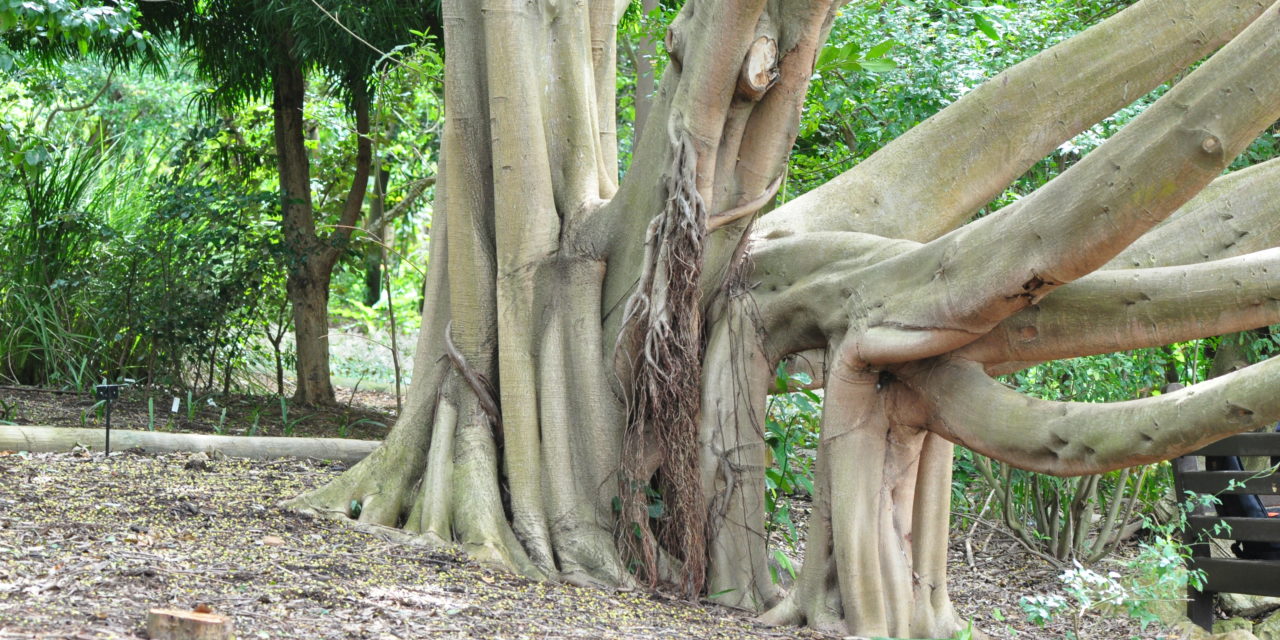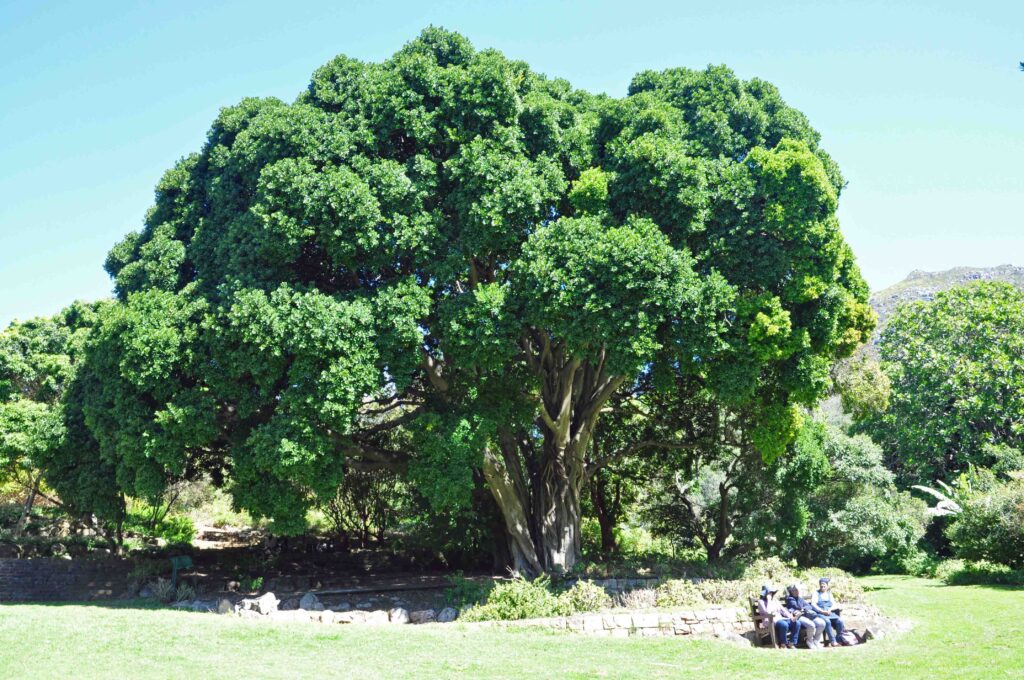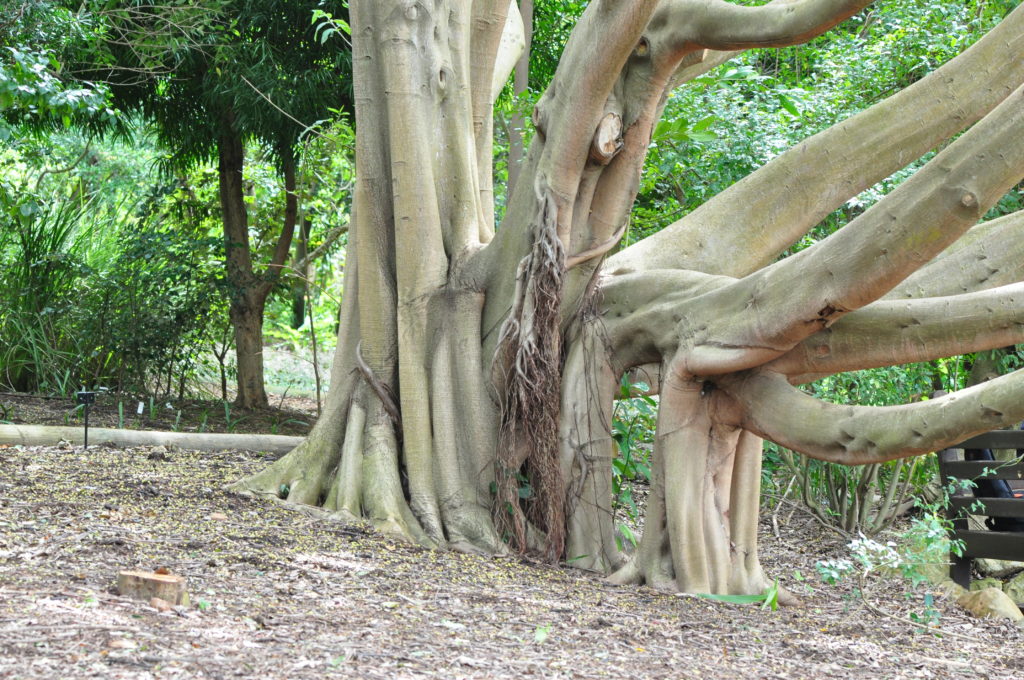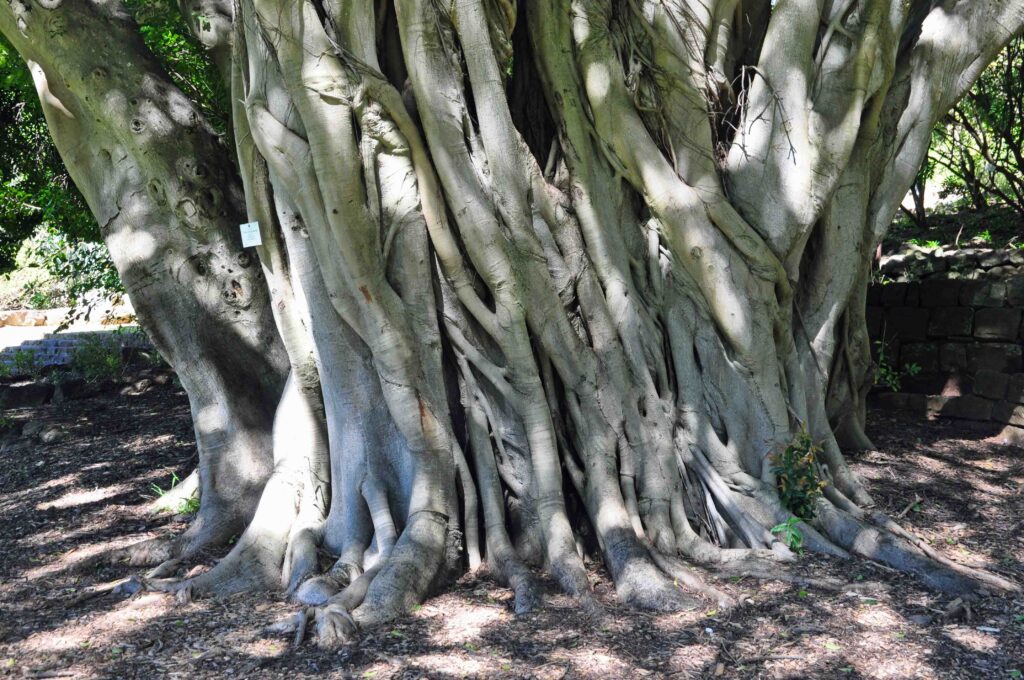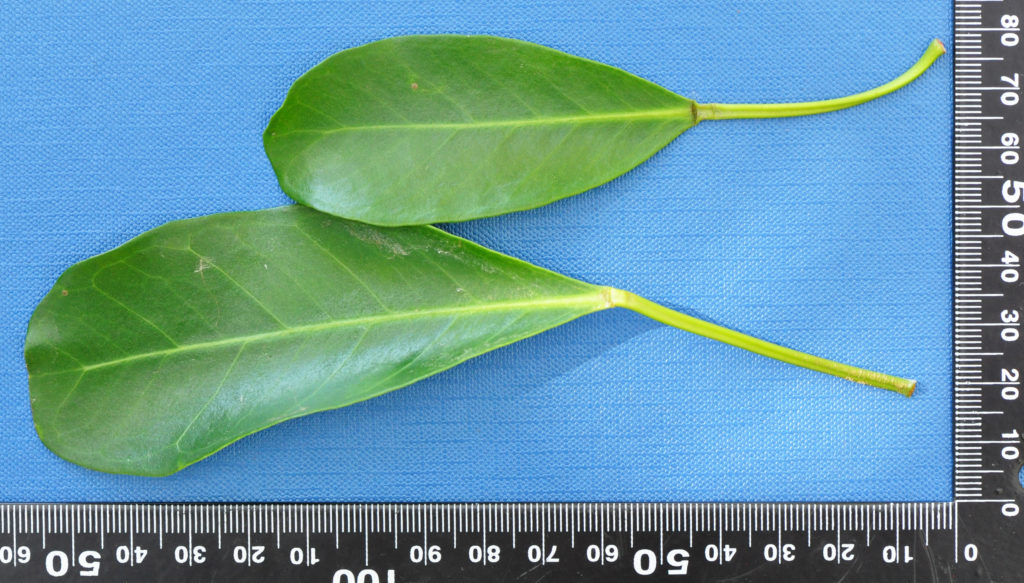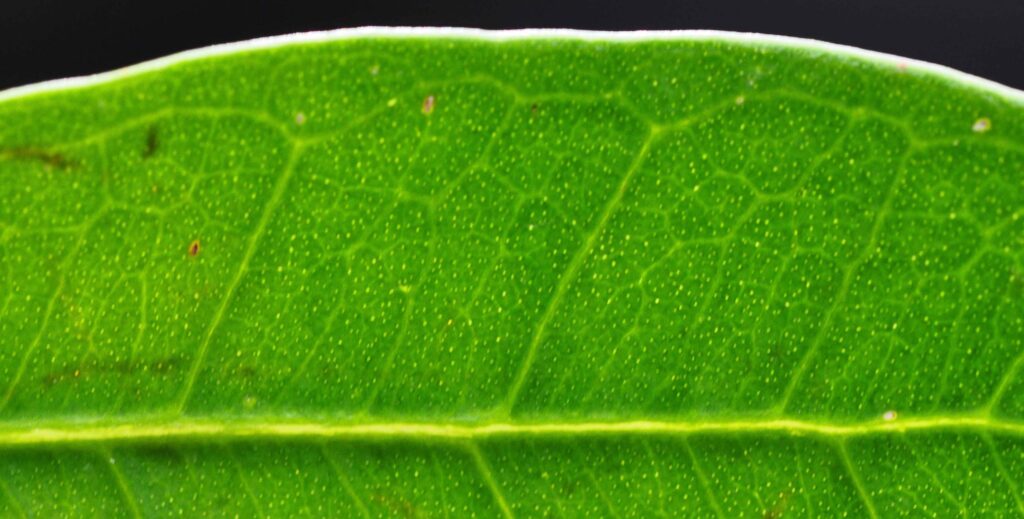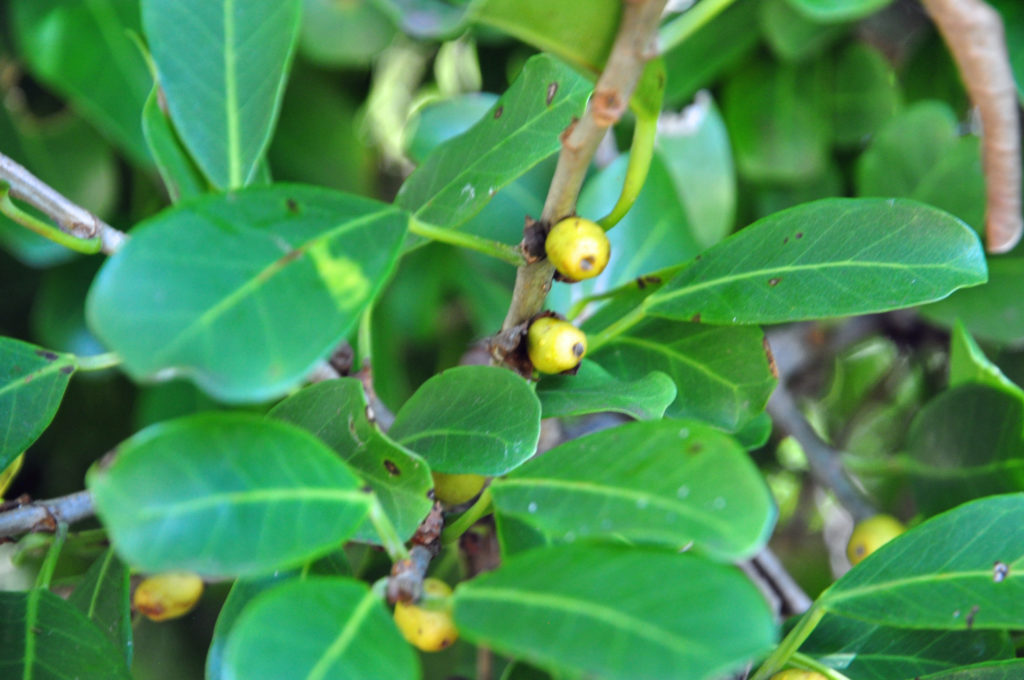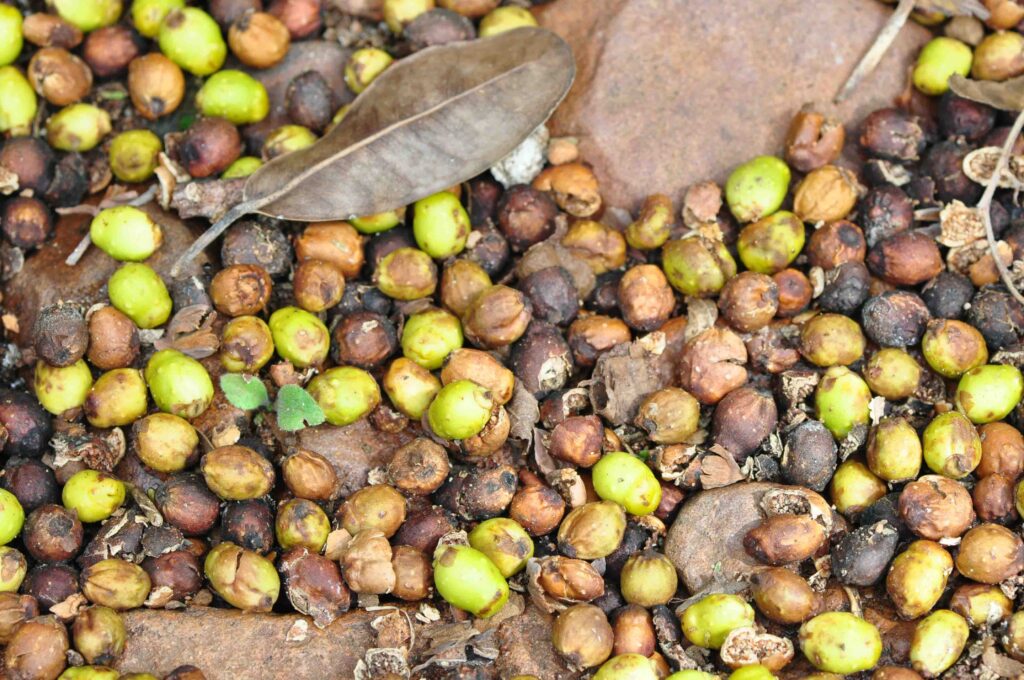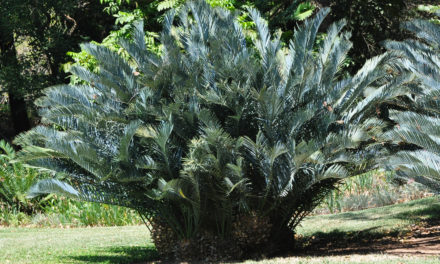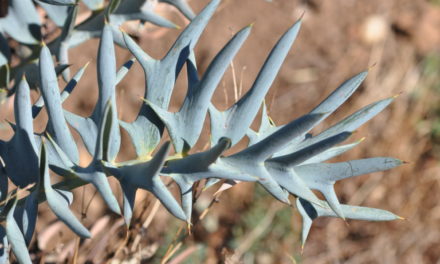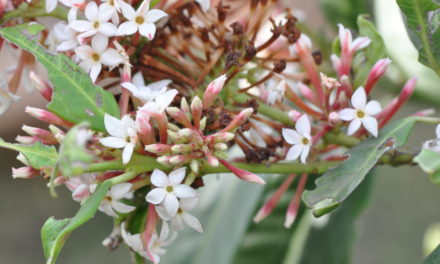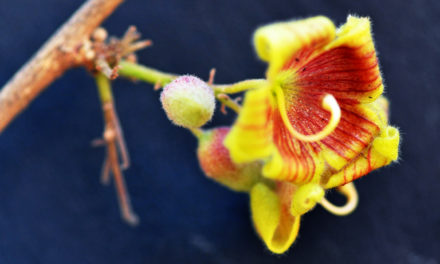General Info – summary
The monoecious medium sized Tree is up 20m high and may be solitary or a rock-splitter. Smooth bark is pale grey. The obovate, simple, entire Leaves are spiral or alternate to nearly opposite. The midrib abruptly stops before reaching the apex. Unisexual Flowers are in a syconium – pollinated by specific wasps in a mutualistic relationship. They enter through an ostiole in the small hairless and stalkless Fruit.
Description
Ficus craterostoma
Previous Name: Ficus luteola, Ficus pilosula.
SA Tree No. 52
Common names: (Afr) Baster Natal-vy, Bosvy, Bos-touboom, Rankvy, Stompblaar-bosvy, Stompblaarvy. (Eng) Bastard Natal Fig, Blunt-leaf Fig, Blunt-leaved Forest Fig, Forest Fig, Strangler Fig, Wurgvy. (isiXhosa) Intozane, Uluzi, Umthombe. (isiZulu) Isihlamfane, Umbombe, Umthombe. (Northern Sotho) Moumo. (Tshivenda) Muumo, Muvumo, Tshikululu, Tshikululu. (Xitsonga) Xirhomberhome.
Family: Moraceae (fig or mulberry family). Trees are evergreen and have milky or watery latex present. The simple Leaves are alternate or opposite and 3-veined from near the possibly lobed base. They are usually entire, and all leaves have stipules. Plants are monoecious or dioecious and flowers are unisexual. The Perianth of indigenous species contain sepals but no petals. Male flowers have up to 6 stamens. Female flowers are inconspicuous and lack staminodes. The superior or inferior Ovary has 1 locule with 1 ovule and 2 styles are often present. The compound usually fleshy Fruit contains various Seeds. The family has 37 genera and about 1 100 species.
Name derivation: Ficus – Latin name for fig. craterostoma: crater – bowl shaped and stoma – mouth. This refers to the bowl-shaped ostiole (fig opening). The genus Ficus has 25 species in South Africa.
Conservation: National Status: L C. Least Concern: 2005. (J.E. Burrows and J.E. Victor).
Tree
This small to medium sized Tree may reach 20m high (usually smaller) and may grow on its own. It may also be a strangler fig or a rock-splitter. The Crown is usually round and spreading (photo 231). Strangler roots may be visible (Photo 983) and may affect the shape of the trunk. Horizontal and vertical markings may be visible on the Trunk, which may be buttressed (photo 232). The Bark is smooth, pale grey (photo 983) and may be mottled. Leaf scars are distinctive on young branches (photo 239).
- 231. 2018/09/11. Kirstenbosch NBG. Photo: David Becking.
- 983. 2018/09/15. Kirstenbosch NBG. Photo: David Becking.
- 232. 2018/09/11. Kirstenbosch NBG. Photo: David Becking.
- 239. 2018/09/11. Kirstenbosch NBG. Photo: David Becking.
Leaves
This tree may be deciduous. The spiral or alternate to nearly opposite Leaves are variable. They may reach 10 x 5cm and are simple (have a single blade which may have incisions that are not deep enough to divide the leaf into leaflets). The stiff, slightly glossy and thinly leathery leaves are obovate (the reverse of ovate, the terminal half is broader than the basal – photo 235). The broader Apex may be slightly concave, blunt-tipped or truncate (appearing as if cut of at the end). Up to 10 lateral Veins may be present on both sides. The veins are best observed against a strong light (photo 981). In this picture, tiny white glandular dots are present. The Base tapers narrowly and here the lowermost pair of lateral veins do not distinctly arise near the base. The wavy Margin is entire (with a continuous margin, not in any way indented). The hairless Blade is a shiny, dark green above (photo 233) and lighter below. The Midrib stops abruptly before the apex (photo 235). The Petiole (leaf stalk) is hairless, grooved above (photo 235) and up to 5cm long. The semi persistent Stipules (basal appendages of the petiole) are up to 5mm long, cover the bud and are slightly persistent.
- 235 2018.09.11 Kirstenbosch NBG. Photo: David Becking. Upper surfaces.
- 981 2018.09.15 Kirstenbosch NBG. Photo: David Becking.
Flowers & Fruit
The Figs are spherical or ellipsoidal and up to 1,5cm wide. They develop in leaf axils near branch ends and are usually in pairs. Figs are monoecious (having both male and female reproductive organs on the same plant). Minute individual flowers are within each fig. Figs possess an amazingly arranged flower head called a Syconium. Essentially this consists of a Receptacle (is that expanded tip of the flower stalk from which the floral parts develop. It is greatly expanded in the Compositae / Asteraceae and Ficus). Here the perimeter substantially increases in size and folds over forming the Fig shape. The hollow fig ends with a distinct elongated nipple-like Ostiole. Scales surround this opening, making exit for the 1-2mm long wasps impossible and entrance difficult. Only the female pollinating wasps (Alfonsiella pipithiensis in southern Africa) attempt to do so and may be injured in the process. Around the inner boundary of the figs hollow receptacle, the large collection of extremely small flowers is located. These tiny flowers are unisexual. In the Male flowers, up to 6 overlapping Perianth (the 2 floral envelopes considered together; a collective term for the calyx and corolla) lobes and one or 2 Stamens are present. The Ovary is absent or vestigial (imperfectly developed, non-functional relic from the past and is usually smaller). In the Female flower, there is a free Ovary and 1 or 2 styles. The Stigma is usually oblong. There are no stamens and usually fewer perianth lobes.
Fig scent attracts the Female wasp and she enters the fig through the ostiole, with her pollen sacks laden with pollen and, incidentally, pollinates those female fig flowers with longish styles. These long styles prevent the wasp from reaching the ovary and laying eggs. The wasp targets the flowers with short stigmas and lays a single egg in each one. The female flowers react to this intrusion producing a gall, which nourishes the developing larvae that eventually pupate and becomes adults. The robust Male wasps develop first, fertilize the young Female wasps and then burrow through the wall of the fig allowing oxygen in. The female wasps then, unintentionally, load pollen from the male flowers before escaping from the fig and make their way to another fig, of the same species, to continue the life cycle. This is an excellent example of a mutualistic relationship, (both benefit) which occurs between the fig tree and the wasp. Nearly a week after the wasps have left, the figs with their fertilized seeds, ripen and develop into a speckled Fruit that is up to 1,5cm wide. This development is due to the oxygen induced ethylene production. Ethylene is a small odourless and tasteless hydrocarbon gas. This gas is involved in the ripening of the fruit, including causing the fruit to change colour, texture and soften. Ethylene is used commercially to ripen fruits like tomatoes, bananas and pears. The ripe fig fruit is brown/red to yellowish (photo 233). The figs are axillary on terminal branches. The hairless, stalkless (both distinctive) and slightly warty figs change from having reddish spots to a yellowish-red when ripe. Large quantities of fruit are on the ground in Kirstenbosch NBG – possibly because they are unfertilized (Photo 982). This may be because the specific wasp is absent or is in insufficient numbers. (Nov-Mar).
- 233 2018.09.11 Kirstenbosch NBG. Photo: David Becking.
- 982 2018.09.15 Kirstenbosch NBG. Photo: David Becking.
Distribution & Ecology
These wind resistant trees may be stranglers or lithophytes (plants that grow on rocks in which case they may be rock splitters). They occur where there is a reasonable water supply – in evergreen forest margins, wooded mountain ravines, swamp forests (West Africa) and mist belts. These trees grow below 2 100m and occur naturally from the Great Kei River in the Eastern Cape, KwaZulu-Natal – where they are most common, Mpumalanga and Limpopo. They are also found in Swaziland, western Mozambique, Zimbabwe and northwards into tropical Africa and Arabia. These trees also occur in Sierra Leone in West Africa. Leaves are one of the food sources for the larvae of the attractive common Fig-tree Blue Butterfly Myrina silenusutterfloes. These butterflies occur in the dry western part of the Northern Cape, KwaZulu-Natal and northwards. Birds consume the fruit.
Ethnobotany
This is an impressive tree for a large garden in frost-free areas. Due to the aggressive roots, keep them away from buildings, swimming pools, sewer lines, paving etc. The Fruit is edible but not very tasty (for humans). Open and dry the ripe fruit before planting the tiny seeds. Young stem cuttings are suitable for propagation and this plant is suitable for a container or bonsai. These trees are similar to Ficus natalensis (with its stalked figs and usually blunt-tipped leaf apex) and Ficus burkei (which are usually hairy, and the figs are larger).
References
Boon, R. 2010. Pooley’s Trees of eastern South Africa. Flora and Fauna Publications Trust, Durban.
Bryant, C. Lombo, B. 2004. Trees of CC Africa, Double Story Books, Cape Town.
Burrows, J.E. & Victor, J.E. 2005. Ficus craterostoma Warb. ex Mildbr. & Burret. National Assessment: Red List of South African Plants version 2020.1. Accessed on 2023/06/07.
Burrows, J.E., Burrows, S.M., Lotter, M.C. & Schmidt, E. 2018. Trees and Shrubs Mozambique. Publishing Print Matters (Pty) Ltd. Noordhoek, Cape Town.
Coates Palgrave, M. 2002. Keith Coates Palgrave Trees of Southern Africa, edn 3. Struik, Cape Town.
Lawrence, G. H. M, 1951. Taxonomy of Vascular Plants, The Macmillan Company, New York. Tenth Printing 1965.
Palmer, E. & Pitman, N. 1972. Trees of southern Africa, Balkema, Amsterdam, Cape Town.
Schmidt, S. Lotter, M. & McCleland, W. 2002. Trees and Shrubs of Mpumalanga and the Kruger National Park.
van Wyk, B. & van Wyk, P. 1997 Field guide to Trees of Southern Africa, Struik, Cape Town..
Woodhall, S. 2020. Field Guide to Butterflies of South Africa, edn 2. Donnelley, RR, China.
http://pza.sanbi.org/ficus-craterostoma
https://en.wikipedia.org/wiki/Ficus_craterostoma

